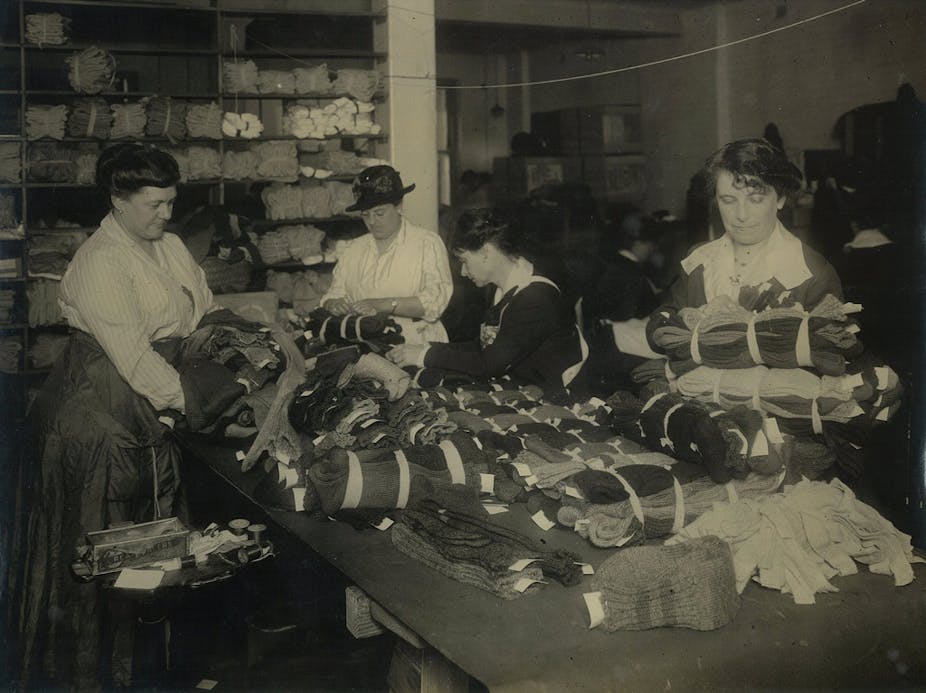During the first world war in Australia there was a restriction of styles of clothing available to both men and women because of shortages in fabrics. Everyday dress became more sombre due to a lack of good quality dyes – and in any case bright colours were seen to be too gay and frivolous.
In the country that rode on the sheep’s back, however, wool was the solution for those serving on the front line. The manufacture of ready-made clothing might have decreased during wartime, but there was an explosion in hand knitting for soldiers.
Socks for the boys
Coordinated though organisations such as the Australian Comforts Fund, groups formed at community centres such as the Melbourne Town Hall where every day up to 40 women would knit socks, vests, balaclavas and kneepads to parcel up and send to the home front.
Thousands of women and schoolchildren knitted throughout the war. Over 1.3 million pairs of socks were sent overseas – often with a small personal note inside the sock informing the digger who had knitted the garment along with a brief message.

In Victoria, when demand exceeded supply, bicycle spokes were turned into knitting needles and sold to other states. Knitting provided comfort not only to the men who received the garments but also for the women who knitted. It was a meditative way to pass the time and feel they were contributing to the war effort.
So ingrained was the daily activity of knitting while sitting by the radio waiting to hear news from overseas, that some women, in the years after the war had ended, found themselves reaching instinctively for their needles as soon as the radio was turned on.
The perfect sock
To stop the “rogue knitting” of socks that might be ill-fitting or not well-made the Soldiers’ Sock Fund in Sydney provided instructional talks to help knitters produce the perfect sock. They also published The Grey Sock book in 1915.

After Australia joined the second world war, government departments introduced knitting patterns and clear guidelines about what garments could be knitted, and what styles were suited for the harsh conditions in the field. Knitting book companies such as Patons and Baldwins of Melbourne followed government guidelines and produced booklets such as the Patons Service Woolies: On Duty with the Services, Specialty Knitting Book No 153, which advised knitters to “buy wisely” when purchasing the amount of wool, and to always use the recommended tension so the correct amount of wool would be used.
Along with standard patterns for socks, vest, jumpers and headwear, the pattern book included “Hospital Comforts”: a convalescent jacket with a cutaway back to make lying in bed more comfortable.
A warming commodity

The demand for wool during wartime made it a strategic commodity, and during the world wars Britain purchased the entire Australian wool clip. Despite the export of the wool clip during the first world war, plans were put in place for the sheepskin hides to provide a vest for every Australian soldier abroad.
The Tanned Sheepskin Clothing Committee was set up in 1914 with a plan to produce a million units for the diggers by the end of the war. By 1916 150,000 vests had been made.
Once again the vests were part of a community effort across the country. The Red Cross delivering the tanned sheepskins for volunteers to stitch together, using three sheepskins per vest.
The Korean War in the 1950s was the last war where Australian wool was seen as a strategic commodity.
Wool was still being used to make socks but this time instead of “trench foot” caused by fungal diseases in the trenches soldiers suffered “rice paddy feet”. This was caused by feet being immersed in snow or water for long periods. During this war soldiers would wear two pairs of socks, and sometimes two pairs of trousers, to help combat the freezing cold conditions.
The wool that was sent to Korea was often of poor quality. When made into uniforms the rough and scratchy “prickle effect” left a lasting impression. The reputation of wool suffered – and the industry took years to recover.

